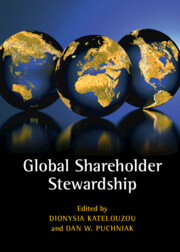Book contents
- Endorsements
- Global Shareholder Stewardship
- Global Shareholder Stewardship
- Copyright page
- Dedication
- Contents
- Figures
- Tables
- Contributors
- Foreword
- Acknowledgements
- Abbreviations
- Part I Foundations
- 1 Global Shareholder Stewardship
- 2 The UK Stewardship Code 2010–2020
- 3 The Market for Stewardship and the Role of the Government
- Part II Jurisdictions
- Part III Comparisons
- Index
3 - The Market for Stewardship and the Role of the Government
from Part I - Foundations
Published online by Cambridge University Press: 28 April 2022
- Endorsements
- Global Shareholder Stewardship
- Global Shareholder Stewardship
- Copyright page
- Dedication
- Contents
- Figures
- Tables
- Contributors
- Foreword
- Acknowledgements
- Abbreviations
- Part I Foundations
- 1 Global Shareholder Stewardship
- 2 The UK Stewardship Code 2010–2020
- 3 The Market for Stewardship and the Role of the Government
- Part II Jurisdictions
- Part III Comparisons
- Index
Summary
The chapter analyses the market for stewardship, as it has been developing in the UK. The 2020 UK Stewardship Code more clearly than previous stewardship codes (both in the UK and elsewhere) articulates the concept of a market for stewardship. The UK Code 2020 takes into account the position of end-investors and beneficiaries. The hope is that stewardship will be delivered because those whose money is invested ask for it. We agree that stewardship does start with those who contribute the funds invested in the market. The focus on end-investors and beneficiaries is, however, not enough. By limiting the analysis to these groups, the UK government overlooks the fact that it is itself a financial contributor to the market. A study commissioned by the Competition and Markets Authority (CMA) finds, for example, that 90% of the revenue of investment consultants and fiduciary managers derives from pensions. The government contributes to pension investments through the provision of tax credit. It is a significant financial investor in the market. Tax credit also deprives end-investors and beneficiaries of a financial incentive to oversee asset owners, asset managers and other service providers. We suggest that the UK government should act as a steward in relation to its own investment and tailor tax credit to investments that are stewardship-active.
Keywords
- Type
- Chapter
- Information
- Global Shareholder Stewardship , pp. 67 - 88Publisher: Cambridge University PressPrint publication year: 2022



